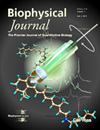Reduced Binding of Tau(210-240) to BIN1: Phosphate Charges Prefer n-Src/Distal Loops over RT-Src Loops.
IF 3.1
3区 生物学
Q2 BIOPHYSICS
引用次数: 0
Abstract
Within the disordered tangles of Tau is a proline-rich region (PRR) which is selectively targeted by the SH3 domain of BIN1, a known genetic factor for Alzheimer's disease, and may hold the key to understanding the disorder and treatment strategies. Hyperphosphorylation of Tau is known to disrupt complex formation, providing researchers with an excellent preventative or remediative targets. This work compiles an extensive (>60 μs) collection of all-atomistic molecular dynamics (MD) simulations of the Tau(210-240) fragment, representing the majority of the P2 subdomain of the PRR, benchmarking various forcefields, phosphorylations, and modifications against experimental NMR chemical shifts and spin-spin coupling for comparison. Additionally, several simulations of the binding complex analyzed for their binding energies by MMGBSA calculations and computational alanine scanning to pinpoint the exact residues involved, and the disruptions caused by the phosphate group. We noted that the additional charges decrease salt-bridges formed by positive residues in Tau, particularly on R221, and negative residues in BIN1 by up to 32%, and a strong preference in Tau, particularly in the latter half, for contact towards the distal and n-Src loops instead of residues in the RT-Src loop.Tau(210-240)与BIN1的结合减少:磷酸盐电荷更喜欢n-Src/远端环而不是RT-Src环。
在Tau蛋白紊乱的缠结中有一个富含脯氨酸的区域(PRR),它被已知的阿尔茨海默病遗传因子BIN1的SH3结构域选择性靶向,可能是理解该疾病和治疗策略的关键。已知Tau的过度磷酸化会破坏复合物的形成,为研究人员提供了一个极好的预防或修复靶点。这项工作编制了广泛的(bbb60 μs)全原子分子动力学(MD)模拟的Tau(210-240)片段,代表了PRR的P2亚域的大部分,对各种力场、磷酸化和针对实验核磁共振化学位移和自旋-自旋耦合的修饰进行了基准比较。此外,通过MMGBSA计算和计算丙氨酸扫描分析了几种结合配合物的结合能,以确定所涉及的确切残基,以及磷酸基引起的破坏。我们注意到,额外的电荷减少了Tau中正残基(特别是R221)和BIN1中负残基形成的盐桥,减少了32%,并且Tau中(特别是在后半部分)强烈倾向于与远端和n-Src环接触,而不是与RT-Src环中的残基接触。
本文章由计算机程序翻译,如有差异,请以英文原文为准。
求助全文
约1分钟内获得全文
求助全文
来源期刊

Biophysical journal
生物-生物物理
CiteScore
6.10
自引率
5.90%
发文量
3090
审稿时长
2 months
期刊介绍:
BJ publishes original articles, letters, and perspectives on important problems in modern biophysics. The papers should be written so as to be of interest to a broad community of biophysicists. BJ welcomes experimental studies that employ quantitative physical approaches for the study of biological systems, including or spanning scales from molecule to whole organism. Experimental studies of a purely descriptive or phenomenological nature, with no theoretical or mechanistic underpinning, are not appropriate for publication in BJ. Theoretical studies should offer new insights into the understanding ofexperimental results or suggest new experimentally testable hypotheses. Articles reporting significant methodological or technological advances, which have potential to open new areas of biophysical investigation, are also suitable for publication in BJ. Papers describing improvements in accuracy or speed of existing methods or extra detail within methods described previously are not suitable for BJ.
 求助内容:
求助内容: 应助结果提醒方式:
应助结果提醒方式:


